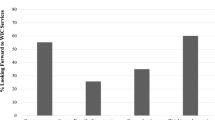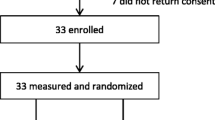Abstract
The Special Supplemental Nutrition Program for Women, Infants and Children (WIC) is a program for low-income women and children under age five. The purpose of this study was to identify barriers to accessing online WIC resources among Latina WIC clients. Five focus groups were conducted with Spanish-speaking participants recruited from a single WIC clinic. Two key themes emerged relating to barriers in accessing WIC’s online resources. The first theme, access issues, included three subthemes: lack of computer/Internet resources; family barriers to computer use; and computer literacy. The second theme, perceived value of the website, included three subthemes: limited time savings; preference for on-site education; and knowledge about the website. This is the first study to evaluate barriers to accessing online resources among Latina women in the WIC program. WIC sites attempting to increase utilization of online resources may be more successful if they serve clients with easy access to a computer with Internet access. They may also consider strategies to increase the value of the online resources, as compared to their current services offered to clients in a face-to-face setting.
Similar content being viewed by others
References
Federal Register. WIC program regulations. Code of Federal Regulations, 7 C.F.R. Part 246; 2009.
Fox HB, McManus MA, Schmidt HJ. WIC reauthorization: opportunities for improving the nutritional status of women, infants, and children. Washington DC; 2003.
Black MM, et al. WIC participation and attenuation of stress-related child health risks of household food insecurity and caregiver depressive symptoms. Arch Pediatr Adolesc Med. 2012;166(5):444–51.
Khanani I, et al. The impact of prenatal WIC participation on infant mortality and racial disparities. Am J Public Health. 2010;100(S1):S204–9.
Ritchie LD, et al. Favorable impact of nutrition education on California WIC families. J Nutr Educ Behav. 2010;42(3S):S2–10.
USDA Food and Nutrition Service. WIC eligible’s and coverage—1994–2007: estimates of the population of women, infants, and children eligible for WIC benefits. Research: WIC Studies 2007; cited 2012: Available from http://www.fns.usda.gov/ora/menu/Published/WIC/WIC.htm.
Woelfel ML, et al. Barriers to the use of WIC services. J Am Diet Assoc. 2004;104(5):736–43.
Boe DT, Riley W, Parsons H. Improving service delivery in a county health department WIC clinic: an application of statistical process control techniques. Am J Public Health. 2009;99(9):1619–25.
Brotman BA, Bumgarner M, Prime P. Client flow through the women, infants, and children public health program. J Health Care Finance. 1998;25(1):72–7.
Bensley RJ, et al. Wichealth.org: impact of a stages of change-based Internet nutrition education program. J Nutr Educ Behav. 2006;38(4):222–9.
Livingston G. Latinos and digital technology, 2010. Washington DC: Pew Hispanic Center; 2011.
Hesse B, et al. Trust and sources of health information. Arch Intern Med. 2005;165:2618–24.
Gordon NP, Iribarren C. Health-related characteristics and preferred methods of receiving health education according to dominant language among Latinos aged 25–64 in a large Northern California health plan. BMC Public Health. 2008;8:305–14.
Hudson JC, Watts E. Hispanic preferences for health care providers and health care information. Health Mark Q. 1996;14(1):67.
Larson E, Wong-McLoughlin J, Ferng YH. Preferences among immigrant Hispanic women for written educational materials regarding upper respiratory infections. J Community Health. 2009;34(3):202–9.
Scheinmann R, et al. Evaluating a bilingual video to improve infant feeding knowledge and behavior among immigrant Latina mothers. J Community Health. 2010;35(5):464–70.
Vassilev Z, et al. Assessment of barriers to utilization of poison centers by Hispanic/Latino populations. J Toxicol Environ Health A. 2006;69(18):1711–8.
Yee BWK, Weaver GD. Ethnic minorities and health promotion: developing a culturally competent agenda. Generations. 1994;18(1):39.
Britigan D, Murnan J, Rojas-Guyler L. A qualitative study examining Latino functional health literacy levels and sources of health information. J Community Health. 2009;34(3):222–30.
Miller EA, West DM, Wasserman M. Health information websites: characteristics of US users by race and ethnicity. J Telemed Telecare. 2007;13(6):298–302.
Krueger RA, Casey MA. Focus groups: a practical guide for applied research. 4th ed. Thousand Oaks: SAGE Publications; 2009.
Harris JE, et al. An introduction to qualitative research for food and nutrition professionals. J Am Diet Assoc. 2009;109:80–90.
Bowen GA. Naturalistic inquiry and the saturation concept: a research note. Qual Res. 2008;8:137–52.
Braun V, Clarke V. Using thematic analysis in psychology. Qual Res Psychol. 2006;3(2):77–101.
Evans BC, Coon DW, Crogan NL. Personalismo and breaking barriers: accessing Hispanic populations for clinical services and research. Geriatr Nurs. 2007;28(5):289–96.
Dyrness A. Confianza is where I can be myself: Latina mothers’ constructions of community in education reform. Ethnogr Educ. 2007;2(2):257–71.
Ayón C, Aisenberg E. Negotiating cultural values and expectations within the public child welfare system: a look at familismo and personalismo. Child Fam Soc Work. 2010;15(3):335–44.
Peña-Purcell N. Hispanics’ use of Internet health information: an exploratory study. J Med Libr Assoc. 2008;96(2):101–7.
Hunter BD, Neiger B, West J. The importance of addressing social determinants of health at the local level: the case for social capital. Health Soc Care Community. 2011;19(5):522–30.
Abbott S, Freeth D. Social capital and health. J Health Psychol. 2008;13(7):874–83.
Salovey P, et al. Bridging the digital divide by increasing computer and cancer literacy: community technology centers for head-start parents and families. J Health Commun. 2009;14(3):228–45.
Author information
Authors and Affiliations
Corresponding author
Rights and permissions
About this article
Cite this article
Vehawn, J., Richards, R., West, J.H. et al. Identifying Barriers Preventing Latina Women from Accessing WIC Online Health Information. J Immigrant Minority Health 16, 699–705 (2014). https://doi.org/10.1007/s10903-013-9801-0
Published:
Issue Date:
DOI: https://doi.org/10.1007/s10903-013-9801-0




